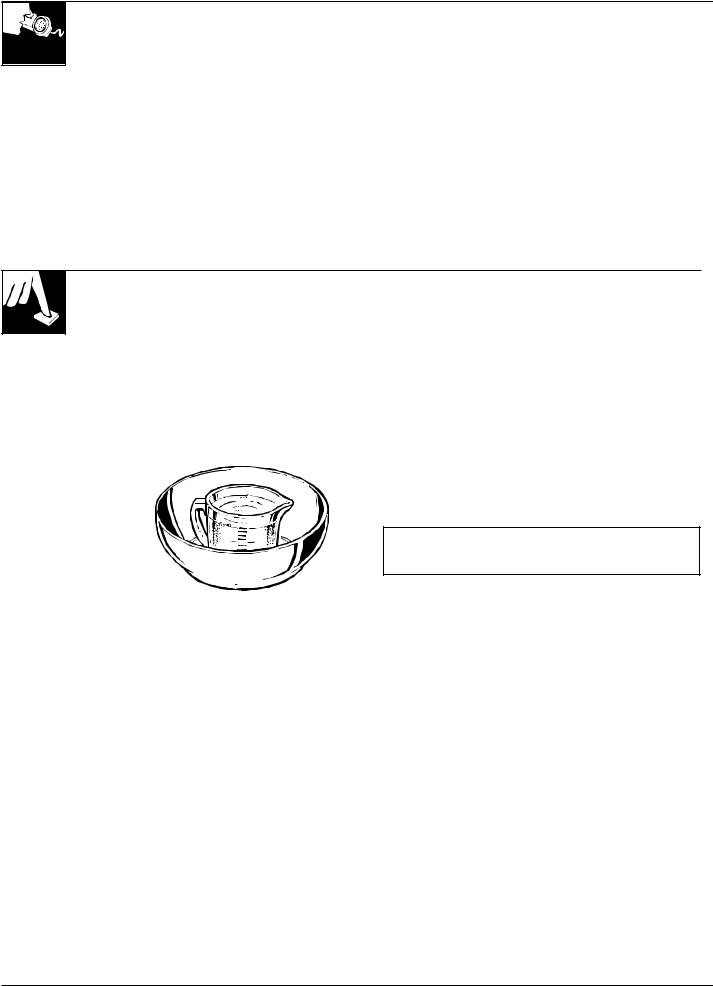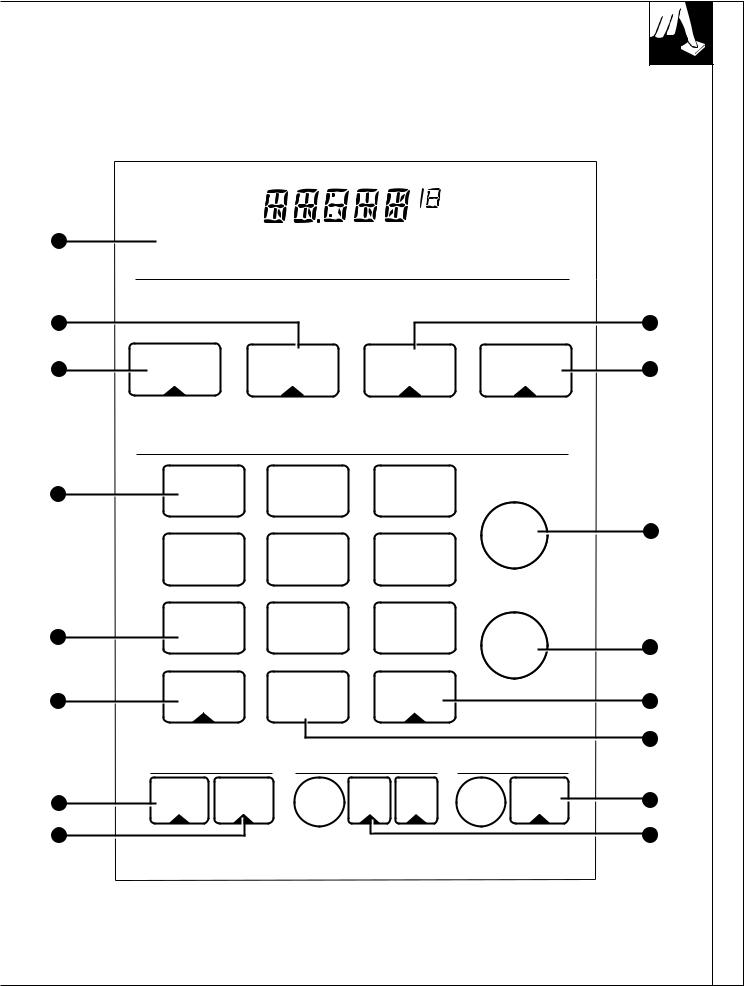GE JVM230, JVM231 User Manual

UseandCare&CookingGuide
Spacemaker® Microwave Oven
Safety Instructions.................... |
3–5 |
|
Precautions to Avoid Possible Exposure |
||
to Excessive Microwave Energy............. |
2 |
|
Operating Instructions, Tips |
||
Aluminum Foil ........................... |
4, 16, 17, 19 |
|
Auto Defrost.................................................. |
|
15 |
Auto Defrost Guide...................................... |
|
16 |
Automatic Fan Feature............................. |
5, 7 |
|
Clock .................................................................. |
|
8 |
Control Panel............................................... |
|
8, 9 |
Cooking by Time................................... |
|
12, 13 |
Cooking Complete Reminder ................... |
10 |
|
Cooking Guide .............................................. |
|
20 |
Defrosting by Time ...................................... |
|
14 |
Defrosting Guide ...................................... |
|
19 |
Delayed Cooking ...................................... |
|
11 |
Delay Start ..................................................... |
|
13 |
Exhaust Fan.......................................... |
|
5, 7, 23 |
Express Cook Feature ................................. |
13 |
|
Features.......................................................... |
|
10 |
Glossary of Microwave Terms.................. |
17 |
|
Heating or Reheating Guide .................. |
18 |
|
Hold Time ................................................... |
|
11 |
Kitchen Timer................................................ |
|
11 |
Microwaving Tips ........................................... |
|
6 |
Popcorn .......................................................... |
|
13 |
Power Levels ......... |
7, 8, 11, 12, 14, 18–20 |
|
Problem Solver............................... |
25 |
More questions ?…call |
|
GE Answer Center® 800.626.2000
Care and Cleaning.................... |
|
21–23 |
Exhaust Fan................................................... |
|
23 |
Grease Filter............................................... |
|
23 |
Light Bulb Replacement ......................... |
|
22 |
Installation.......................................... |
|
24 |
Adapter Plugs ............................................... |
|
24 |
Extension Cords ........................................... |
|
24 |
Grounding Instructions............................... |
|
24 |
Consumer Services................... |
|
27 |
Appliance Registration.................................. |
|
2 |
Important Phone Numbers........................ |
|
27 |
Model and Serial Number Location |
...........2 |
|
Warranty ........................................ |
Back Cover |
|
Models: JVM230 |
|
Microwave power |
JVM231 |
|
output |
|
|
of this oven is 850 watts. |
|
||
|
|
|
GE Appliances

HELP US HELP YOU…
Before using your oven, read this guide carefully.
It is intended to help you operate and maintain your new microwave oven properly.
Keep it handy for answers to your questions.
If you don’t understand something or need more help, call:
GE Answer Center® 800.626.2000
24 hours a day, 7 days a week
Write down the model and serial numbers.
You’ll find them on a label inside the oven.
These numbers are also on the Consumer Product Ownership Registration Card that came with your microwave oven. Before sending in this card, please write these numbers here:
Model Number
Serial Number
Use these numbers in any correspondence or service calls concerning your microwave oven.
Be sure your microwave oven is registered.
It is important that we know the location of your microwave oven should a need occur for adjustments.
Your supplier is responsible for registering you as the owner.
Please check with your supplier to be sure he has done so; also send in your Consumer Product Ownership Registration Card. If you move, or if you are not the original purchaser, please write to us, stating model and serial numbers.
This appliance must be registered. Please be certain that it is.
Write to:
GE Appliances
Range Product Service
Appliance Park
Louisville, KY 40225
If you received a
damaged oven...
Immediately contact the dealer (or builder) that sold you the oven.
Save time and money.
Before you request service...
Check the Problem Solver in the back of this guide. It lists causes of minor operating problems that you can correct yourself.
All these things are normal with your microwave oven.
•Steam or vapor escaping from around the door.
•Light reflection around door or outer case.
•Dimming oven light and change in blower sound may occur while operating at power levels other than high.
•Dull thumping sound while oven is operating.
•Some TV-Radio interference might be noticed while using your microwave oven. It’s similar to the interference caused by other small appliances and does not indicate a problem with your oven.
PRECAUTIONS TO AVOID POSSIBLE EXPOSURE TO EXCESSIVE MICROWAVE ENERGY
(a)Do Not Attempt to operate this oven with the door open since open-door operation can result in harmful exposure to microwave energy. It is important not to defeat or tamper with the safety interlocks.
(b)Do Not Place any object between the oven front face and the door or allow soil or cleaner residue to accumulate on sealing surfaces.
(c)Do Not Operate the oven if it is damaged. It is particularly important that the oven door close properly and that there is no damage to the:
(1)door (bent)
(2)hinges and latches (broken or loosened)
(3)door seals and sealing surfaces.
(d)The Oven Should Not be adjusted or repaired by anyone except properly qualified service personnel.
2

IMPORTANT SAFETY INSTRUCTIONS
Read All Instructions Before Using Your Appliance.
When using electrical appliances, basic safety precautions should be followed, including the following:
WARNING–To reduce the risk of burns, electric shock, fire, injury to persons or exposure to excessive microwave energy:
•Read and follow the specific ‘‘Precautions to Avoid Possible Exposure to Excessive Microwave Energy’’ on the previous page.
•This appliance must be grounded. Connect only to properly grounded outlet. See Grounding Instructions section in the back of this guide.
•Use this appliance only for its intended use as described in this guide. Do not use corrosive chemicals or vapors in this appliance. This microwave oven is specifically designed to heat or cook food, and is not intended for laboratory or industrial use.
•This over-the-range oven was designed
for use over ranges no wider than 42 inches.
It may be installed over both gas and electric cooking equipment.
•For best operation, plug this appliance into its own electrical outlet, to prevent flickering of lights, blowing of fuse or tripping of circuit breaker.
•Do not mount this appliance over a sink. Install or locate this appliance only in accordance with the provided Installation Instructions.
•Do not cover or block any openings on the appliance.
•Do not store this appliance outdoors. Do not use this product near water—for example, in a wet basement, near a swimming pool or near a sink.
•This microwave oven is not approved or tested for marine use.
•Do not store anything directly on top of the microwave oven surface when the oven is in operation.
•Do not immerse power cord or plug in water.
•Keep power cord away from heated surfaces.
•Do not let power cord hang over edge of table or counter.
•Do not operate this appliance if it has a damaged power cord or plug, if it is not working properly, or if it has been damaged or dropped.
•See door surface cleaning instructions in the Care and Cleaning section(s) of this guide.
•This appliance should be serviced only by qualified service personnel. Contact nearest authorized service facility for examination, repair or adjustment.
•As with any appliance, close supervision is necessary when used by children.
•To reduce the risk of fire in the oven cavity:
—Do not overcook food. Carefully attend appliance if paper, plastic or other combustible materials are placed inside the oven to facilitate cooking.
—Remove wire twist-ties and metal handles from paper or plastic containers before placing them in the oven.
—Do not use your microwave oven to dry newspapers.
—Do not use recycled paper products. Recycled paper towels, napkins and waxed paper can contain metal flecks which may cause arcing or ignite. Paper products containing nylon or nylon filaments should be avoided, as they may also ignite.
—Do not pop popcorn in your microwave oven unless in a special microwave popcorn accessory or unless you use popcorn labeled for use in microwave ovens.
—Do not overcook potatoes. They could dehydrate and catch fire, causing damage to your oven.
—Do not operate the oven while empty to avoid damage to the oven and the danger of fire. If by accident the oven should run empty a minute or two, no harm is done. However, try to avoid operating the oven empty at all times—it saves energy and prolongs the life of the oven.
(continued next page)
3
Instructions Safety Important

IMPORTANT SAFETY INSTRUCTIONS
(continued)
—Do not use the oven for storage purposes.
Do not leave paper products, cooking utensils or food in the oven when not in use.
—If materials inside oven should ignite, keep oven door closed, turn oven off, and disconnect power cord, or shut off power at the fuse or circuit breaker panel.
•Some products such as whole eggs and sealed containers—for example, closed jars—will explode and should not be heated in this microwave oven. Such use of the microwave oven could result in injury.
•Avoid heating baby food in glass jars, even with the lid off. Make sure all infant food is thoroughly cooked. Stir food to distribute the heat evenly.
Be careful to prevent scalding when warming formula or breast milk. The container may feel cooler than the milk really is. Always test the milk before feeding the baby.
•Don’t defrost frozen beverages in narrow necked bottles (especially carbonated beverages). Even if the container is opened, pressure can build up. This can cause the container to burst, possibly resulting in injury.
•Use foil only as directed in this guide.
TV dinners may be microwaved in foil trays less than 3/4″ high; remove the top foil cover and return the tray to the box. When using foil in the microwave oven, keep the foil at least 1 inch away from the sides of the oven.
• Cookware may become hot because of heat transferred from the heated food. Pot holders may be needed to handle the cookware.
•Foods cooked in liquids (such as pasta) may tend to boil over more rapidly than foods containing less moisture. Should this occur, refer to the Care and Cleaning section(s) for instructions on how to clean the inside of the oven.
•Thermometer—Do not use a thermometer in food you are microwaving unless the thermometer is designed or recommended for use in the microwave oven.
•Plastic cookware—Plastic cookware designed for microwave cooking is very useful, but should be used carefully. Even microwave-safe plastic may not be as tolerant of overcooking conditions as are glass or ceramic materials and may
soften or char if subjected to short periods of overcooking. In longer exposures to overcooking, the food and cookware could ignite. For these reasons: 1) Use microwave-safe plastics only and use them in strict compliance with the cookware manufacturer’s recommendations. 2) Do not subject empty cookware to microwaving.
3) Do not permit children to use plastic cookware without complete supervision.
•When cooking pork, follow the directions exactly and always cook the meat to an internal temperature of at least 170°F. This assures that, in the remote possibility that trichina may be present in the meat, it will be killed and meat will be safe to eat.
•Do not boil eggs in a microwave oven. Pressure will build up inside egg yolk and will cause it to burst, possibly resulting in injury.
• Foods with unbroken outer ‘‘skin’’ such as potatoes, sausages, tomatoes, apples, chicken livers and other giblets, and egg yolks (see previous caution) should be pierced to allow steam to escape during cooking.
•Not all plastic wrap is suitable for use in microwave ovens. Check the package for proper use.
•Spontaneous boiling—Under certain special circumstances, liquids may start to boil during or shortly after removal from the microwave oven. To prevent burns from splashing liquid, we recommend the following: before removing the container from the oven, allow it to stand in the oven for 30 to 40 seconds after the oven has shut off. Do not boil liquids in narrow-necked containers such as soft drink bottles, wine flasks and especially narrow-necked coffee cups. Even if the container is opened, excessive steam can build up and cause it to burst or overflow.
4

•‘‘Boilable’’ cooking pouches and tightly closed plastic bags should be slit, pierced or vented
as directed by package. If they are not, plastic could burst during or immediately after cooking, possibly resulting in injury. Also, plastic storage containers should be at least partially uncovered because they form a tight seal. When cooking with containers tightly covered with plastic wrap, remove covering carefully and direct steam away from hands and face.
• Hot foods and steam can cause burns. Be careful when opening any containers of hot food, including popcorn bags, cooking pouches and boxes. To prevent possible injury, direct steam away from hands
and face.
The Exhaust Hood
•Have it installed and properly grounded by a qualified installer. See the special installation booklet packed with the microwave oven.
•The exhaust fan in the oven will operate automatically under certain conditions (see Automatic Fan Feature). While the fan is operating, caution is required to prevent the starting and spreading of accidental cooking fires while the exhaust fan is in use. For this reason:
—Never leave surface units unattended at high heat settings. Boilovers cause smoking and greasy spillovers that may ignite and spread if exhaust fan is operating. To minimize automatic fan operation, use adequate sized cookware and use high heat only when necessary.
—In the event of a grease fire,
smother flaming pan on surface
unit by covering pan completely with well-fitting lid, cookie sheet or flat tray.
—Clean the vent hood often. Do not allow grease to build up on the hood or the filter.
—Use care when cleaning the vent hood filter.
Corrosive cleaning agents, such as lye-based oven cleaners, may damage the filter.
—When flaming foods are under the hood, turn the fan off. The fan, if operating, may spread the flame.
SAVE THESE
INSTRUCTIONS
Optional Accessories
Available at extra cost from your GE supplier.
JX40WH Filler Panel Kit (for models JVM230WV and JVM231WV).
JX41 Filler Panel Kit (for models JVM230BV and JVM231BV).
JX50 Glass Canopy Kit
JX81A Charcoal Filter Kit for non-vented installation.
This microwave oven is UL listed for installation over electric and gas ranges.
5
Instructions Safety Important

IF YOU NEED SERVICE…
To obtain service, see the Consumer Services page in the back of this guide.
We’re proud of our service and want you to be pleased. If for some reason you are not happy with the service you receive, here are 3 steps to follow for further help.
FIRST, contact the people who serviced your appliance. Explain why you are not pleased. In most cases, this will solve the problem.
NEXT, if you are still not pleased, write all the details—including your phone number—to:
Manager, Consumer Relations
GE Appliances
Appliance Park
Louisville, KY 40225
FINALLY, if your problem is still not resolved, write:
Major Appliance Consumer Action Panel
20 North Wacker Drive
Chicago, IL 60606
MICROWAVING TIPS
•Make sure all cookware used in your microwave oven is suitable for microwaving. Most glass casseroles, cooking dishes, measuring cups, custard cups, pottery or china dinnerware which does not have metallic trim or glaze with a metallic sheen can be used. Some cookware is labeled “suitable for microwaving.”
• If you are not sure if a dish is
microwave-safe, use this test: Place in the oven both the dish you are testing and a glass
measuring cup filled with 1 cup of
water—set the measuring cup either in or next to the dish. Microwave 1 minute at high. If the dish heats, it should not be used for microwaving. If the dish remains cool and only the water in the cup heats, then the dish is microwave-safe.
•Paper towels, waxed paper and plastic wrap can be used to cover dishes in order to retain moisture and prevent spattering. Be sure to vent plastic wrap so steam can escape.
•Some microwaved foods require stirring, rotating or rearranging. Check the Cooking Guide.
•Steam builds up pressure in foods which are tightly covered by a skin or membrane. Pierce potatoes, egg yolks and chicken livers to prevent bursting.
If you use a meat thermometer while cooking, make sure it is safe for use in microwave ovens.
6

VARIABLE POWER LEVELS (1–10)
How to Change Power Level
1. Press MICRO COOK or TIME DEFROST.
2. |
Select cooking or defrosting time. |
1 |
2 |
3 |
|
3. |
Press POWER LEVEL. |
EXPRESS COOK EXPRESS COOK |
EXPRESS COOK |
||
4 |
5 |
6 |
|||
4. |
Select desired power level 1–10. |
EXPRESS COOK EXPRESS COOK |
|||
7 |
8 |
9 |
|||
5. |
Press START. |
||||
|
0 |
|
|||
|
|
|
|
||
Variable power levels add flexibility to your microwave cooking. The power levels on your microwave oven can be compared to the surface units on a range. High (Power Level 10) or full power is the fastest way to cook and gives you 100% power. Each power level gives you microwave energy a certain percent of the time. Power Level 7 is microwave energy 70% of the time. Power Level 3 is energy 30% of the time.
A high setting (10) will cook faster but may need additional attention such as frequent stirring, rotating or turning over. Most of your cooking will be done on High (Power Level 10). A lower setting will cook more evenly and with less attention given to stirring or rotating the food. Some foods may have better flavor, texture or appearance if one of the lower settings is used. You may wish to use a lower power level when cooking foods that have a tendency to boil over, such as scalloped potatoes.
Rest periods (when the microwave energy cycles off) give time for the food to “equalize” or transfer heat to the inside of the food. An example of this is shown with Power Level 3—the defrost cycle. If microwave
energy did not cycle off, the outside of the food would cook before the inside was defrosted.
Here are some examples of uses for various power levels:
POWER LEVEL |
BEST USES |
High 10 |
Fish, bacon, vegetables, |
|
boiling liquids. |
Med-High 7 |
Gentle cooking of meat and |
|
poultry; baking casseroles |
|
and reheating. |
|
|
Medium 5 |
Slow cooking and tenderizing |
|
such as stews and less tender |
|
cuts of meat. |
|
|
Low 3 |
Defrosting without cooking; |
|
simmering; delicate sauces. |
|
|
Warm 1 |
Keeping food warm without |
|
overcooking; softening butter. |
|
|
AUTOMATIC FAN FEATURE
This microwave oven has an automatic fan feature to protect it from too much heat rising from the cooktop or range beneath it. It automatically turns on at a low speed if it senses too much heat.
If you have turned the fan on you may find that you cannot turn it off. This is because the automatic fan has come on to protect the internal parts of the microwave.
The fan will automatically turn off when the internal parts are cool. It may stay on for 30 minutes or more after the range and microwave controls have been turned off.
7
Feature Fan Auto Levels Power Variable Tips Microwaving …Service Need You If

YOUR TOUCH CONTROL PANEL
The Touch Control Panel allows you to set the oven controls with the touch of a finger. It’s designed to be easy to use and understand.
1.DISPLAY. Displays time of day, cooking time, power level being used, cooking mode and instructions.
2.TIME DEFROST. Gentle thawing at automatic Power Level 3 (Low).
3.MICRO COOK. Microwave for a selected amount of time using automatic Power Level 10 (High).
4.EXPRESS COOK. Touch number pads 1 through 5 for 1 to 5 minutes of cooking. No need to touch START, the oven will start immediately.
5.NUMBER PADS. Touch these pads to program the microwave.
6.POWER LEVEL. Touch this pad before entering another power level number if you want to change from automatic Power Level 10 (High) for cooking or Power Level 3 (Low) for defrosting.
7.KITCHEN TIMER. This feature uses no microwave energy. It functions as either a kitchen timer, as a holding period after defrost or as a delay timer before time cooking.
8.CLOCK. Touch this pad to enter time of day or check time of day while microwaving. To set clock, first touch CLOCK pad and then enter time of day. For example, if time is 1:30, touch number pads 1, 3 and 0 and ‘‘1:30’’ will appear in display. Then touch START or CLOCK pad. To reset or change time, simply repeat above process.
9.AUTO DEFROST. Touch this pad and food weight, then START. The oven automatically sets power levels and defrosting time.
10.POPCORN. Touch this pad to cook prepackaged microwave popcorn weighing 3.0 to 3.5 ounces. No need to touch START, the oven will start immediately.
11.START. After all selections are made, touch this pad to start the oven.
12.CLEAR/OFF. When touched, it shuts off the oven and erases all settings (except time of day).
13.DELAY START. Allows you to program your oven to begin cooking at a preset time of day— up to a 12-hour delay.
14.CLOCK DISPLAY ON/OFF. Touch the 0 number pad to turn the clock display on or off. The Clock Display On/Off feature cannot be used while a cooking feature is in use.
15.SURFACE LIGHT. Touch ON to turn on the surface light.
16.VENT FAN. Press HI, LO or OFF for the different fan speeds.
When You Plug in the Oven
The display panel displays “88888”, “18 POWER” and all of the oven functions. After 15 seconds, all lights disappear and ‘‘RESET’’ appears in the upper portion. Touch the CLEAR/OFF pad, set the Clock and oven is ready for use.
This will happen any time there is a power outage.
8

|
|
|
|
|
|
|
POWER |
|
|
|
|
1 |
|
|
ENTER FOOD TEMP COOK |
NO |
SOUND |
|
|
|
|
||
|
|
WEIGHT LBS. DEF |
TIME |
I II |
CODE |
|
|
|
|
||
2 |
|
|
|
|
|
|
|
|
|
9 |
|
3 |
MICRO |
|
|
TIME |
|
AUTO |
POPCORN |
10 |
Touch Your |
||
COOK |
|
DEFROST |
|
DEFROST |
|||||||
|
|
|
|
|
|
||||||
|
1 |
|
|
2 |
|
|
3 |
|
|
|
|
4 |
|
|
|
|
|
|
|
Control |
|||
|
EXPRESS COOK |
|
EXPRESS COOK |
|
EXPRESS COOK |
|
|
|
|||
|
4 |
|
|
5 |
|
|
6 |
START |
11 |
||
|
|
|
|
|
|
||||||
|
|
|
|
|
|
|
|
||||
|
EXPRESS COOK |
|
EXPRESS COOK |
|
|
|
|
|
Panel |
||
5 |
7 |
|
|
8 |
|
|
9 |
CLEAR |
|
||
|
|
|
|
12 |
|
||||||
|
|
|
|
|
|
|
|
|
OFF |
|
|
|
|
|
|
|
|
|
|
|
|
|
|
|
POWER |
|
0 |
|
DELAY |
|
|
|
|
||
6 |
LEVEL |
|
|
|
START |
|
|
13 |
|
||
|
|
|
|
DISPLAY ON/OFF |
|
|
|
|
|
|
|
|
|
|
|
|
|
|
|
|
|
14 |
|
|
TIME |
|
VENT FAN |
|
SURFACE LIGHT |
|
|
||||
|
KITCHEN |
CLOCK |
OFF |
LO |
|
HI |
OFF |
ON |
15 |
|
|
7 |
TIMER |
|
|
||||||||
8 |
|
|
|
|
|
|
|
|
|
16 |
|
|
|
|
|
|
|
|
|
|
|
|
9 |
